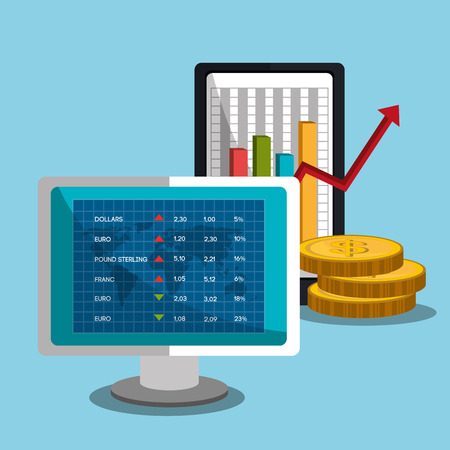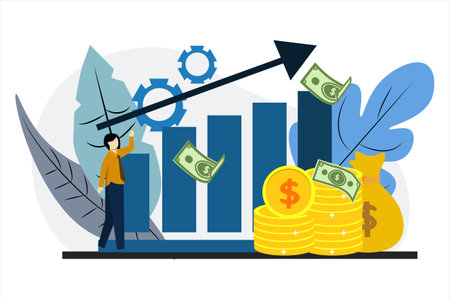1. Introduction to Inflation Indicators
Inflation is a fundamental economic concept that affects everyone, from individual consumers to large businesses and government policymakers. It represents the rate at which the general level of prices for goods and services rises, eroding purchasing power over time. Understanding inflation and how it is measured helps individuals and organizations make informed financial decisions.
What Is Inflation?
Inflation occurs when the prices of goods and services increase over a period of time, reducing the value of money. A moderate level of inflation is considered normal in a growing economy, but excessive inflation can lead to economic instability. Conversely, deflation, or a decrease in prices, can also be harmful by discouraging spending and investment.
Why Tracking Inflation Matters
Monitoring inflation is crucial because it influences financial planning and economic policies. Here’s why it matters:
- Consumers: Helps individuals understand changes in their cost of living and adjust budgets accordingly.
- Businesses: Assists companies in setting prices, managing costs, and making investment decisions.
- Policymakers: Guides central banks and governments in making monetary and fiscal policy adjustments to maintain economic stability.
Main Indicators for Measuring Inflation
There are several ways to measure inflation, but two of the most commonly used indicators are the Consumer Price Index (CPI) and the Producer Price Index (PPI). These indices provide valuable insights into price trends at different levels of the economy.
| Indicator | Description | Who It Affects Most |
|---|---|---|
| Consumer Price Index (CPI) | Measures changes in the prices paid by consumers for goods and services. | Consumers, households, policymakers |
| Producer Price Index (PPI) | Tracks changes in the selling prices received by producers for their goods and services. | Businesses, manufacturers, suppliers |
How CPI and PPI Work Together
The CPI and PPI are closely related but serve different purposes. The PPI often acts as a leading indicator for CPI since changes in producer costs can eventually impact retail prices. By analyzing both indices, economists can gain a clearer picture of inflation trends across various sectors.
Key Takeaways
- Inflation affects purchasing power and overall economic stability.
- Tracking inflation helps consumers, businesses, and policymakers make informed decisions.
- The CPI reflects consumer-level price changes, while the PPI measures producer-level price shifts.
- Both indicators provide essential insights into inflation trends.
Understanding these key indicators is essential for navigating economic changes effectively. In the next section, well dive deeper into how CPI is calculated and its impact on everyday life.
2. What Is CPI? Understanding the Consumer Price Index
The Consumer Price Index (CPI) is one of the most widely used economic indicators for measuring inflation. It tracks changes in the prices of a basket of goods and services that households typically purchase, providing insight into how the cost of living evolves over time.
How CPI Measures Inflation
CPI is calculated by analyzing price changes in various categories of consumer spending. The U.S. Bureau of Labor Statistics (BLS) collects data on thousands of products and services across different regions to ensure accuracy. The index reflects the average price change for these items over a specified period.
Main Categories in CPI Calculation
The CPI includes a broad range of expenditures grouped into major categories:
| Category | Examples |
|---|---|
| Food & Beverages | Groceries, restaurant meals, coffee |
| Housing | Rent, homeownership costs, utilities |
| Transportation | Gasoline, vehicle purchases, public transit |
| Medical Care | Doctor visits, prescription drugs, insurance premiums |
| Education & Communication | Tuition fees, internet service, mobile plans |
| Recreation & Apparel | Entertainment, clothing, footwear |
(1) Types of CPI Measurements
The BLS publishes different versions of the CPI to reflect various consumer groups and economic conditions:
- CPI-U (Consumer Price Index for All Urban Consumers): Covers about 93% of the U.S. population and is the most commonly cited measure.
- CPI-W (Consumer Price Index for Urban Wage Earners and Clerical Workers): Focuses on households where at least half of income comes from wage-earning jobs.
- Core CPI: Excludes volatile food and energy prices to provide a clearer view of long-term inflation trends.
(2) How CPI Affects Everyday Life
The CPI impacts several aspects of daily life, including:
- Wages and Salaries: Many employers adjust wages based on inflation rates to maintain employees’ purchasing power.
- Social Security Benefits: Adjustments to Social Security payments are often tied to changes in CPI.
- Interest Rates: The Federal Reserve monitors CPI when setting monetary policy decisions that affect loan and mortgage rates.
- Cost of Living Adjustments (COLA): Some government programs and contracts include automatic adjustments based on CPI changes.
Limitations of CPI as an Inflation Measure
While CPI is a valuable tool for tracking inflation, it has some limitations:
- Does Not Represent All Consumers: CPI focuses primarily on urban consumers and may not fully reflect rural spending patterns.
- Substitution Bias: When prices rise, consumers may switch to cheaper alternatives, but CPI calculations do not always account for this behavior.
- Lags in Data Collection: Since data collection takes time, CPI figures might not immediately reflect sudden economic shifts.
- Exclusion of Certain Costs: Some expenses, such as investment-related costs or asset prices like real estate values, are not included in the index.
The Role of CPI in Economic Policy
The government and financial institutions rely on CPI data to make informed decisions about economic policies. By understanding how inflation affects consumers, policymakers can adjust interest rates, taxation policies, and social benefits to maintain economic stability.

3. What Is PPI? Understanding the Producer Price Index
Overview of the PPI
The Producer Price Index (PPI) measures the average change over time in the selling prices received by domestic producers for their goods and services. Unlike the Consumer Price Index (CPI), which tracks price changes from the consumer’s perspective, PPI focuses on businesses and how much they charge for their products at different stages of production.
How PPI Differs from CPI
While both PPI and CPI are key indicators of inflation, they serve different purposes:
| Factor | PPI | CPI |
|---|---|---|
| Measures | Price changes from the producer’s perspective | Price changes from the consumer’s perspective |
| Focus | Wholesale and production-level pricing | Retail and consumer-level pricing |
| Affected by | Raw material costs, supply chain expenses | Consumer demand, taxes, distribution costs |
| Main Use | Helps businesses and policymakers understand cost pressures on producers | Shows how inflation impacts everyday consumers |
Main Components of PPI
PPI is divided into three major categories:
(1) Industry-Level PPI
This measures price changes within specific industries, such as manufacturing, agriculture, or construction.
(2) Commodity-Based PPI
This tracks price fluctuations for specific goods and raw materials like oil, steel, and food products.
(3) Stage-of-Processing PPI
This evaluates price changes at different production stages—raw materials, intermediate goods, and finished products.
The Importance of PPI in Inflation Tracking
PPI serves as a leading indicator of inflation because changes in producer prices often trickle down to consumers. If businesses face higher production costs, they may pass those costs onto consumers through higher retail prices, eventually influencing CPI.
4. CPI vs. PPI: Key Differences and Their Impact
When analyzing inflation, both the Consumer Price Index (CPI) and Producer Price Index (PPI) serve as essential indicators. However, they measure different aspects of price changes in the economy. Understanding their differences and respective impacts can help businesses, investors, and policymakers make informed decisions.
Key Differences Between CPI and PPI
The primary distinction between CPI and PPI lies in what they measure and who is affected by the price changes. Below is a comparison of these two inflation indicators:
| Factor | CPI (Consumer Price Index) | PPI (Producer Price Index) |
|---|---|---|
| Definition | Measures the average change in prices paid by consumers for goods and services. | Measures the average change in selling prices received by domestic producers for their output. |
| Main Audience | Consumers | Businesses and Producers |
| Scope of Measurement | Includes retail prices of goods and services such as food, housing, transportation, and healthcare. | Focuses on wholesale prices of raw materials, intermediate goods, and finished products before reaching consumers. |
| Impact on Economy | Affects consumer purchasing power, cost of living, and monetary policy decisions. | Influences production costs, profit margins, and business pricing strategies. |
| Use in Policy Making | Guides central bank policies on interest rates and inflation control. | Helps assess supply-side inflationary pressures affecting businesses. |
The Importance of CPI and PPI in Economic Policies
(1) Monetary Policy Decisions
The Federal Reserve closely monitors CPI to determine inflation trends that influence interest rate adjustments. A rising CPI may prompt the Fed to raise interest rates to curb inflation, while a declining CPI could lead to rate cuts to stimulate economic growth.
(2) Business Pricing Strategies
PPI serves as a leading indicator for future CPI changes. When producer costs rise significantly, businesses often pass these costs to consumers, eventually driving up CPI. Companies use PPI data to anticipate cost fluctuations and adjust pricing strategies accordingly.
(3) Investment Market Reactions
Financial markets react differently to changes in CPI and PPI. Higher-than-expected CPI readings can lead to stock market volatility as investors anticipate potential interest rate hikes. Meanwhile, significant increases in PPI may signal upcoming inflationary pressure on corporate earnings.
How CPI and PPI Influence Financial Markets
(1) Stock Market Impact
Investors analyze both CPI and PPI to gauge economic health. Rising CPI may trigger concerns about tighter monetary policy, potentially causing stock sell-offs. On the other hand, increasing PPI can indicate higher input costs for companies, affecting profit margins.
(2) Bond Market Considerations
Bonds are highly sensitive to inflation data. If CPI rises unexpectedly, bond yields tend to increase as investors demand higher returns to compensate for reduced purchasing power. Conversely, lower CPI may support bond prices due to expectations of stable or lower interest rates.
(3) Currency Exchange Rates
CPI plays a crucial role in currency valuation. Higher inflation relative to other countries can weaken a nations currency as purchasing power declines. Central banks may adjust interest rates based on CPI trends, influencing forex markets.
Understanding the differences between CPI and PPI helps investors, businesses, and policymakers navigate economic conditions more effectively. While both indices measure inflation from different perspectives, their combined analysis provides valuable insights into price movements across various sectors.
5. Why CPI and PPI Matter for Investors and Businesses
Understanding the Consumer Price Index (CPI) and Producer Price Index (PPI) is essential for investors and businesses because these indicators influence interest rates, stock markets, and business strategies. By analyzing these inflation metrics, companies and investors can make more informed financial decisions.
How CPI and PPI Affect Interest Rates
The Federal Reserve closely monitors CPI and PPI when making decisions about interest rates. Inflation trends reflected in these indices influence monetary policy.
(1) Federal Reserve Policy
- High CPI & PPI: The Fed may raise interest rates to control inflation.
- Low CPI & PPI: The Fed may lower interest rates to stimulate economic growth.
(2) Borrowing Costs
- Businesses: Higher interest rates increase borrowing costs for expansion or operations.
- Consumers: Rising interest rates make mortgages, car loans, and credit card debt more expensive.
Impact on Stock Markets
CPI and PPI fluctuations can significantly impact stock market performance. Investors watch these indicators to predict market trends.
| CPI/PPI Trend | Stock Market Impact |
|---|---|
| Rising CPI/PPI | Higher inflation can lead to rate hikes, reducing corporate profits and causing stock prices to decline. |
| Falling CPI/PPI | If inflation slows down, lower rates can boost stock valuations by making borrowing cheaper. |
CPI and PPI in Business Decision-Making
Businesses use CPI and PPI data to set pricing strategies, manage costs, and plan for future economic conditions.
(1) Pricing Strategies
- If PPI rises, businesses may pass increased production costs to consumers, leading to higher retail prices.
- If CPI rises faster than wages, consumers may cut back on spending, forcing businesses to adjust pricing strategies.
(2) Supply Chain Management
- A rising PPI signals higher raw material costs, prompting businesses to secure supply contracts early or find alternative suppliers.
- A declining PPI suggests lower production costs, which may allow companies to expand profit margins without raising prices.
(3) Wage Adjustments
- If CPI increases significantly, employees may demand higher wages to keep up with the cost of living.
- If inflation remains stable, businesses have more flexibility in managing payroll expenses.
CPI and PPI are crucial tools for understanding economic trends. Whether youre an investor assessing market risks or a business owner planning long-term strategies, tracking these inflation indicators provides valuable insights into financial decision-making.


